Catfish fight really hard, taste good when on the table and thus become an entertaining catch. These catfishing tips are not just for the bank angler but also for those who prefer to fish on boats, lakes, and rivers.
The best catfish fishing tip is to never stop learning about catfish. The more you understand their behavioral patterns and predict them correctly, the higher your catch rate will be. Also, don’t get emotionally attached to a spot. If you haven’t caught anything for an hour, move to a new location.
Even if you are not a seasoned angler, you can still follow along pretty easily. These catfishing tips have repeatedly given us both small and massive catches in different water bodies under various conditions.
Best Tips For Catching Catfish
#1 Locate A Good Fishing Spot
Ask Around In Local Shops
The best way to do that is to go to a local bait, tackle shop, and ask around. Buy some worms, or some baits from them and ask for any catfish tips related to where they go. See where some big catfish are being caught. You can also Google online and look up fishing reports for your area.
Google Maps
Another excellent way to do this is to go on Google Maps and scout out the area for big lakes and rivers. Our favourite spot for catching catfish was found using Google Maps. There’s a little bit of a hike out there and a beautiful sandbar.
Usually, the water is pretty high, but the sandbar stands out. We’ve had a lot of camps out here, cooked with friends, etc. It was and still is a great fishing spot, and we found it all thanks to Google Maps.
Facebook Groups
Also, there are a lot of Facebook groups based on areas. Some examples are the Kansas City area fishing group, Lee’s Summit area, and a Smithville Lake fishing area Facebook Page. Check using Google Maps whether or not the spots in these areas are accessible.
Also, you can ask in catfishing groups on Facebook whether or not there is a good catfish spot near your place.
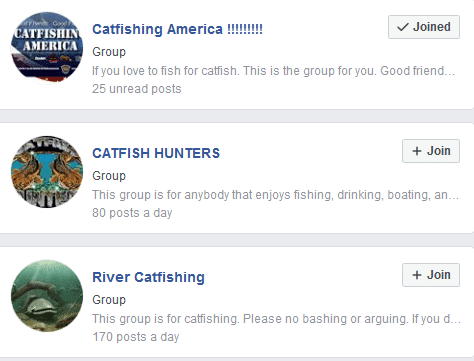
#2 Don’t Fall For The Bait (Useless Ones)
Worms For Small Catfish
We are going to make this simple. The best baits that we found for catfish are worms and live or cut baits. Worms are the key to everything. You can pick these up from Walmart at a cheap price, and then you can use them for the smaller catfish like 1 to 5 lbs ones.
Or you can use them to catch the bait for the bigger catfish. Worms are your key to catching small catfish and also getting the bait for the larger catfish. If you are fishing for smaller channel catfish, then use a size-1 circle hook. We caught some of our best catfish with a big juicy nightcrawler.
Cut Those Worms For Bigger Catfish
If you plan on going for a bigger catfish, take those same worms, cut up in tiny pieces on a really small hook. Then fish them under a bobber in local creeks or small ponds and catch some bluegill. We caught some mooneye, and they cut bait.
We are fishing for these catfish while usually using sizes of about maybe one inch by two inches. And if we’re fishing for smaller catfish, then we’ll grab a one by one inch piece of cut bait. A lot of times, we catch the bluegill live or sometimes it is the sunfish.
Artificial Baits Aren’t As Effective
Worms are your key. They are the best way to go. Do artificial baits work? Not nearly as well as worms because worms are just natural baits. These fishes are naturally feeding on worms, and they’re naturally feeding on baitfish like bluegill or whatever you can catch through worms.
Also, try and stick to fresh baits instead of frozen baits. Use frozen baits as a last resort, i.e., when you have no baits.
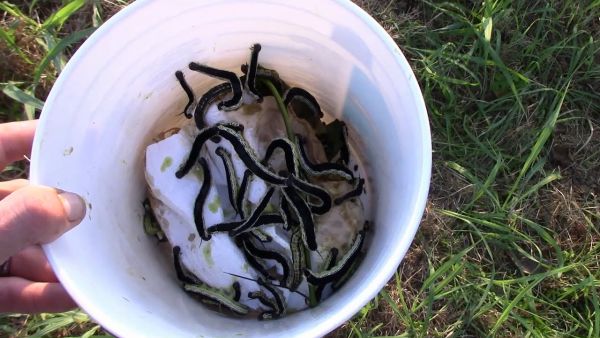
#3 Don’t Play Against Probability
Use A Variety Of Tackle
Learn how to maximize your odds. When you go catfishing, you want as many different baits, rods, and reels as possible. For example, in Missouri, you can have three poles per person if they’re not labelled.
But if you label your rod and reels with your name, address, and conservation number, you can have up to thirty-three rods and reels out as long as you’re using no more than thirty-three hooks. Thus, make sure you have a lot of different options.
Have Variety In Natural Baits Too
Fish with cut baits, worms, and live baits too. We usually use at least two to three different baits and probably about six poles. For the best results, try and match what the catfish are already feeding on in the area. They are much more likely to take the bait.
Such catfish tips and tricks that suggest matching the natural diet of the fish can be applied to any kind of fishing in general and is a good habit to adopt.
#4 Circle Hooks Are A Great Choice
Why Should You Focus On Circle Hooks?
A great thing about circle hooks is that they are self-setting, and the fish are a lot less likely to swallow the hook. Another beautiful thing about circle hooks is that when you have many poles, it is impossible to be ready to set the hook immediately. With a circle hook, you don’t have to set the hook.
You keep the line taut, and when the fish starts to take the bait, the hook naturally comes around and hooks them. You don’t have to be there to set the hook like the J hook. That allows you to fish with a lot more poles, whether you’re on a lake or a river, bank, or on a boat.
You can be a little more passive, a little lazier, and just have more poles spread out. You could even be eating hotdogs with your friends while the catfish bites.
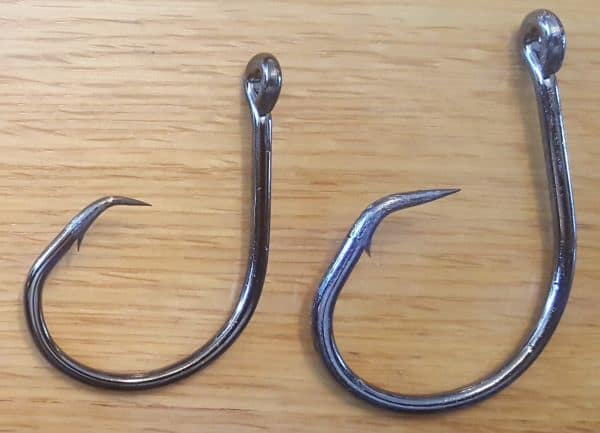
Use The Right Hook Size
Small circle hooks or any circle hook with a small gap is practically of no use while catching catfish. The gap needs to be large. Also, when putting in the bait, make sure that the hook gap is clear enough. You can ensure this by attaching only a small part of the bait to the top part of the hook.
Ensure That You Are Using Sharp Hooks
The catfish doesn’t have a thin mouth structure like the bass, crappie or your other freshwater fish. Its mouth is quite thick due to all the cartilage, and it requires a really sharp, strong hook to pierce it.
#5 Use A Slip Sinker Rig (Modified Carolina)
The Carolina rig is famous as the Slip Sinker Rig among catfish anglers. It is essentially the same rig as the Carolina except for the fact that the tackle used is quite different. This rig allows weight to slide up and down your mainline freely. Hence, when a fish starts taking your baits, they don’t feel much resistance.
Thus, they’re more likely to hang onto that bait a little bit longer and get hooked. While fishing on a river, you need about an eight-ounce weight, and if you were fishing on a lake, this would be a one or two-ounce weight.
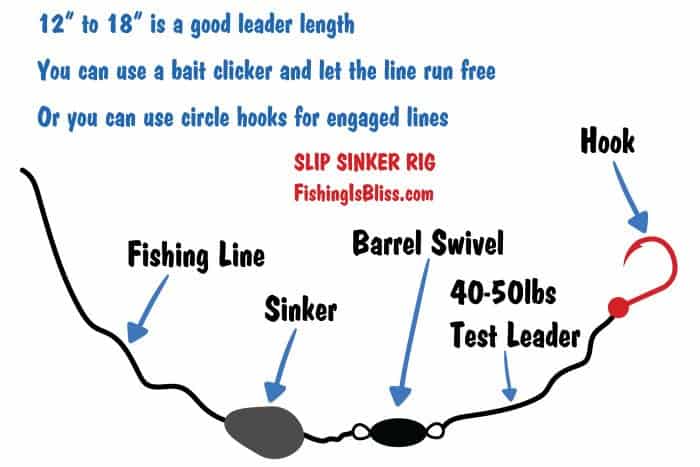
Focus On The Swivel
Make sure your swivel is stronger than your string, so you’re not breaking it before your string. The Slip Sinker is just a free sliding weight, which allows you to get a better hookset ratio, and the fishes are less likely to spit out the hook.
#6 Failure To Plan Is Your Plan To Failure
When we say catfishing fishing tips, we are talking about all the varieties of catfish in general. However, each of those species has its own unique traits. Thus it would be in your best interest to study the kind of catfish you are aiming for.
Study their behaviour, what they respond to, and you’ll get a fair idea of what exactly you need to do the next time you go out to catch catfish. Do this religiously as your homework, and you will see a massive improvement in your catch rate.
Below is an image of some common types of catfish. Go on and study more about them.
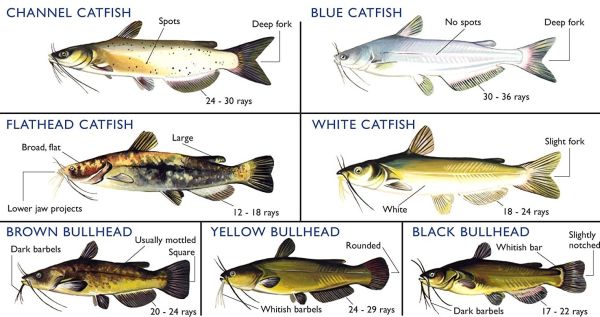
#7 Try Catching Catfish During Daytime
Yes! You read that one right. Due to a lot of myths floating around, some anglers stick to fishing for catfish at nights only. This is nothing but reducing your chances of success by 50%.
Though catfish in certain areas are remarkably active during the night and the probability of a bite increases significantly, it isn’t a general rule. A lot of big catfish come into the shallow waters from deep waters both during the day and at night.
There is no logical evidence to suggest that you cannot catch them easily during the day.
Try Stinky Floating Baits At Night
If you are fishing at night, then stinky baits are quite useful as catfish feed using their sense of smell and touch after dark. Stinky floating baits using jigs, bobbers etc. take this a step further as the scent leaves a trail for the catfish to follow.
However, knowing your species well is a necessity because using a stinky bait for something like a blue catfish, flatheads or large channel catfish hinders your chances of success instead of increasing them.
#8 Follow The One Hour Principle
When you show up at a fishing spot, you should move within an hour if you do not catch anything. If you don’t find anything in one place for an hour, then there’s probably no actively feeding fish in that area at that specific time.
You might want to come back later in the day, maybe in the evening or at night, and might find the fish biting left and right. Just sitting there for hours won’t catch you anything. Stop wasting your time. There have been nights where we’ve had five or six fishes over 20 pounds in thirty minutes.
And then when we came back the next day at the same time, under the same conditions, we caught nothing. So, you got to try different times and different spots while catfishing.

#9 Use The Right Gear
The worst thing that you can do to yourself is to take the wrong gear type while catching a particular type of catfish. This is where doing your ‘homework’ beforehand becomes even more essential.
You don’t want to be devoid of a great catch just because the gear that you chose to take wasn’t capable of handling the catfish species you were planning on catching. Don’t be cheap. Invest in good gear that is known to serve well while catching catfish. This also applies to your fishing line.
Change it regularly so that it doesn’t snap when you are about to catch your biggest catfish.
Lip Grips Are A Must For Beginners
Catfish are known to have a bad temper. Beginners are the ones who suffer the most while handling and releasing a catfish as they tend to stick their hand in the catfish’s mouth the wrong way. Thus, we suggest you stick to using lip grips while handling catfish, especially if you are a beginner.
With time you’ll get the hang of the right way to handle a catfish.
#10 Know When & Where To Look For Catfish
Catfish are migratory by nature and love covers. Also, some species of catfish like the blue catfish move upstream and downstream quite regularly whereas a few species like the flathead catfish are more lazy and territorial. Catfish are also fond of water currents.
Thus, trying to catch one after a good rain or in conditions of a flood will always yield better results. In these conditions, sources of food are abundant, which tempts the catfish to come out of their covers.

#11 Use A High Visibility Line
Using a highly visible line, especially the bright coloured ones like orange, yellow and green, allow you to see the movement of the line clearly. Whether it is the bite, slack in the line or the catfish swimming sideways with your line, you’ll have a clear view.
Don’t Go Gaga Over Braided Lines
When it comes to catching catfish, we feel that braided lines are a bit too overrated. Apart from the fact that these are expensive and destructive to our fishing gear, we never had exceptional differences in catfish catch rates as compared to when we used other fishing lines.
#12 Initially Refrain From Investments In Specialized Catfish Gear
The word specialized in no way means expensive. That’s a big misconception out of the way. Yes, it is always beneficial to use a rod and reel which has a great track record for catching catfish. Also, certain manufacturers have tackles specially designed for catching catfish. These exist for a reason.
However, initially, you should look for more general rods and reels, especially if you are a beginner. It makes no sense to invest in a specialized catfish gear when you are yet to discover the different facets of fishing. You will be missing out on many other fish types. Take your time.
If you enjoy catfishing so much that even after 6 months you still feel the need to invest in a specialized catfish gear, then, by all means, go for it.
#13 Incorporate Drift Fishing Into Your Technique
Don’t worry if the name seems scary. It is one of the most straightforward techniques to catch catfish, especially for beginners considering how simple it is. If you are fishing on a boat, then cast out lots of baits from one side of the boat.
You can easily do this by using multiple rods with the right hooks and bait (remember tips for catching catfish #2, #3 and #4?). Let the boat move (read drift with the wind). That’s it. The baits will automatically drag along, and it is tough not to catch a catfish if you are using this technique.
#14 Keep A Record Of Your Trips
This is a catfish fishing tip that won’t yield immediate results but is a goldmine in the long run if done correctly and regularly. Start recording the data from every catfish trip you go on. You can maintain a journal for the same.
Record data like water temperature, water depth, wind speed and direction, where you were fishing, time of the day, month, type of structure and covers, rod and reel used, type of bait, catfish caught, total time taken, and anything you think is worth recording.
You don’t need the exact number or metric for wind speed or water temperature. Anything relative like warm, cold, mild breeze, etc. is fine.
Raw Data Will Transform Into Information
Start recording these and with time you’ll start noticing a pattern. There will be days with lots of catches, and there will be days with no catches along with everything in between. Repeat your conditions and actions if you want to catch a lot of fish.
Tweak things for days that recorded the worst catch rates and see if things improve. And there you have it— your very own catfish catching ‘algorithm’ which tells you exactly what you need to do.
Factors like water temperature, wind speed, time of the year, etc. are significant dictators of fish movement and behaviour. Observe their behaviour and capitalize. This is something we don’t see even the best of the anglers talk about.
You don’t need to make the same mistake. Start journaling.

#15 Don’t Kill For Fun
What’s the number one catfishing secret to ensure that you and others keep on catching catfish in abundance in the future too? Stop killing them for fun. Practice catch, photograph (optional) and release religiously to ensure there are catfish left for everyone else.
Take one home with you only when you absolutely plan on eating it. There have been horror stories of fish populations dwindling rapidly in a water body just because there were enough fishes for everyone’s need but not everyone’s greed.
Conclusion
We hope you enjoyed this article. These catfishing tips have helped us catch some huge catfish. For those of you who are just entering into the world of catfish, fret not. Just stick to the basics, and you’ll be good to go. And in case you need any help, our catfish tips are right above!
Also, we are curious to see what you guys think about these catfishing tips and tricks. We would love to hear from you.
